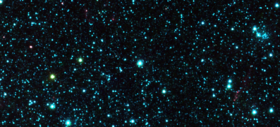Astronomy:PMMR 62
From HandWiki
Short description: Star
| Observation data Equinox J2000.0]] (ICRS) | |
|---|---|
| Constellation | Tucana |
| Right ascension | 00h 53m 47.932s[1] |
| Declination | −72° 02′ 09.487″[1] |
| Characteristics | |
| Spectral type | K3-M1.5 Ia-Ib[2] |
| Astrometry | |
| Radial velocity (Rv) | 141.743±1.139[1] km/s |
| Proper motion (μ) | RA: 0.797[1] mas/yr Dec.: −1.064[1] mas/yr |
| Details | |
| Radius | 1,306[lower-alpha 1][3] R☉ |
| Luminosity | 145,000[2] - 250,000[3] L☉ |
| Surface gravity (log g) | −0.5[3] cgs |
| Temperature | 3,575[3]-4,339[4] K |
| Other designations | |
PMMR 62, 2MASS J00534794-7202095, TIC 181447098[1] | |
| Database references | |
| SIMBAD | data |
Coordinates: ![]() 00h 53m 47.932s, −72° 02′ 09.487″
PMMR 62 is a red supergiant star located in the Small Magellanic Cloud in the constellation Tucana. It is one of the largest stars known being 1,306 solar radii. If it was placed in the Solar System, it would engulf the orbit of Jupiter.[3]
00h 53m 47.932s, −72° 02′ 09.487″
PMMR 62 is a red supergiant star located in the Small Magellanic Cloud in the constellation Tucana. It is one of the largest stars known being 1,306 solar radii. If it was placed in the Solar System, it would engulf the orbit of Jupiter.[3]
See also
Notes
- ↑ Applying the Stefan-Boltzmann Law with a nominal solar effective temperature of 5,772 K:
References
- ↑ 1.0 1.1 1.2 1.3 1.4 1.5 "PMMR 62". Université de Strasbourg. http://simbad.u-strasbg.fr/simbad/sim-id?Ident=PMMR+62&NbIdent=1&Radius=2&Radius.unit=arcmin&submit=submit+id.
- ↑ 2.0 2.1 Davies, Ben; Crowther, Paul A.; Beasor, Emma R. (2018). "The luminosities of cool supergiants in the Magellanic Clouds, and the Humphreys–Davidson limit revisited". Monthly Notices of the Royal Astronomical Society 478 (3): 3138–3148. doi:10.1093/mnras/sty1302. Bibcode: 2018MNRAS.478.3138D.
- ↑ 3.0 3.1 3.2 3.3 3.4 Dicenzo, Brooke; Levesque, Emily M. (2019). "Atomic Absorption Line Diagnostics for the Physical Properties of Red Supergiants". The Astronomical Journal 157 (4): 167. doi:10.3847/1538-3881/ab01cb. Bibcode: 2019AJ....157..167D.
- ↑ Anders, F.; Khalatyan, A.; Chiappini, C.; Queiroz, A. B.; Santiago, B. X.; Jordi, C.; Girardi, L.; Brown, A. G. A. et al. (2019). "Photo-astrometric distances, extinctions, and astrophysical parameters for Gaia DR2 stars brighter than G = 18". Astronomy and Astrophysics 628: A94. doi:10.1051/0004-6361/201935765. Bibcode: 2019A&A...628A..94A.
 |



